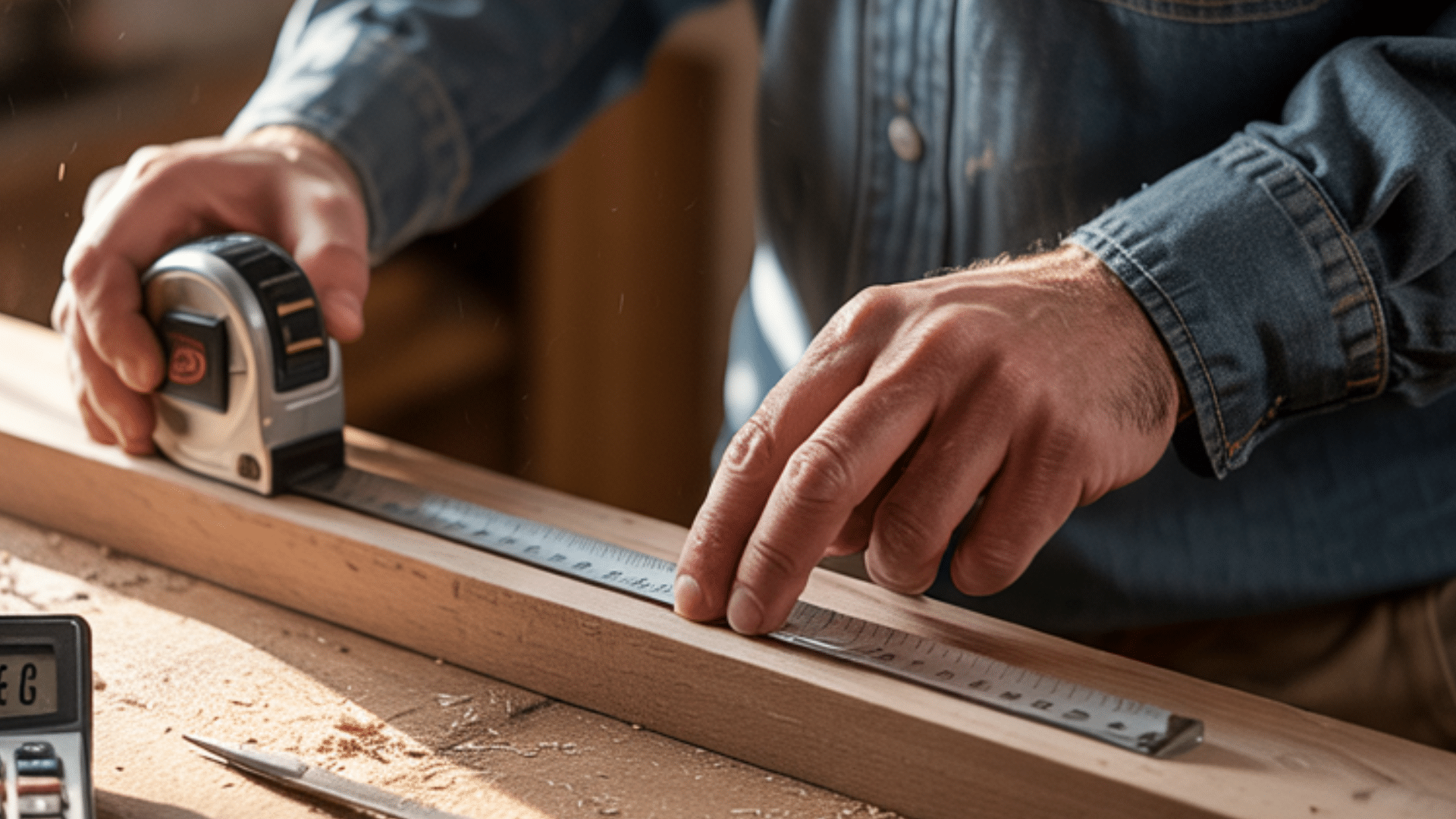Imagine standing before a pile of raw wood, the basic building block of countless projects. Getting your measurements wrong could mean the difference between a masterpiece and a costly mistake.
Many who work with wood fail because they miss this critical first step – accurate measurement. The secret to success lies not just in cutting and joining, but in the numbers that guide your hands.
Three basic methods hold the key: cubic feet for volume, square feet for surface area, and running feet for length. Each serves a unique purpose in remaking simple planks into furniture, homes, and works of art.
Ready to learn the hidden language of wood? The formulas and techniques you’re about to learn will change how you approach every woodworking task from this moment forward.
Tools for Measuring Wood
Let’s look at what should be in your measuring arsenal:
| Tool | Purpose | Best For |
|---|---|---|
| Tape Measure | General measurements | Longer distances, curved surfaces |
| Ruler | Precise straight measurements | Small to medium pieces, detail work |
| Caliper | Exact small measurements | Thickness, diameter, small parts |
| Square | Right angle verification | Checking corners, marking perpendicular lines |
| Calculator | Converting units, calculations | Complex formulas, unit conversions |
Each tool serves a specific function in your wood measuring toolkit. Having all of these on hand ensures you can handle any measurement task that comes your way, from large construction projects to fine furniture work.
How to Measure Wood in Cubic Feet (Volume)

When you need to know the total amount of wood in a piece, cubic feet is what matters. This measurement tells you the space the wood takes up in three dimensions.
- Cubic feet (often shortened to cu ft or ft³) is a unit that measures volume – the total space something takes up.
- One cubic foot equals a cube that’s 1 foot on each side.
Wood sellers, builders, and designers use this unit to talk about how much wood is in a load or piece.
Cubic feet helps you figure out how much a load of wood weighs, how much it might cost, or if it will fit in your workspace. Think of it as measuring the “body” of the wood.
To find cubic feet when your measurements are in inches, use this formula:
Length × Width × Height ÷ 144
The division by 144 is needed to change your inch measurements to feet. This happens because 12 × 12 = 144, accounting for the conversion in all three dimensions.
Let’s try some examples:
Example 1:
|
Example 2:
|
For oddly shaped pieces, break them down into simple shapes, find the cubic feet of each part, then add them together.
Tip: Always double-check your math and units to avoid costly mistakes when ordering or working with wood.
How to Measure Wood in Square Feet (Surface Area)
When working with flat materials like panels, flooring, or decking, square feet becomes your go-to measurement. This focuses on the surface area rather than the total volume.
- Square feet (sq ft or ft²) measures area – The amount of flat space something covers.
- One square foot equals a square that’s 1 foot on each side, which can be written as:
1 ft² = 1 ft × 1 ft
- To calculate square feet, you simply multiply length by width (making sure both are measured in feet):
Square Feet = Length × Width
If your measurements are in other units, you’ll need to convert them first:
Example 1:
|
Example 2:
|
Square footage helps you figure out how many boards you need for a floor, how much wood paneling for a wall, or the size of a tabletop.
Tip: Always add 10-15% extra to your total square footage when buying materials to account for waste, cuts, and mistakes.
How to Measure Wood in Running Feet (Linear Length)
Sometimes all you need to know is how long a piece of wood is – that’s where running feet come in. This measurement focuses only on length, ignoring width and thickness.
- Running feet (also called linear feet): It is simply the length measured in feet. It’s used for items like trim, molding, baseboards, and fence rails where the main concern is length.
To measure running feet, just find the length of the wood in feet:
Running Feet = Length (in feet)
If your measurement is in inches, divide by 12 to get feet:
Example:
|
This measurement helps when you need to figure out:
- How much trim you need to go around a room
- The total length of fencing for a yard
- How much molding to buy for a project
Tip: For projects requiring multiple pieces of the same length, multiply the number of pieces by the running feet of each piece to get your total.
Key Calculations and Conversions You Need to Know

Getting measurements right often means converting between different units. Here are the most useful conversions you’ll need when working with wood:
1. Inches to Feet Conversion: The basic conversion for working with standard measurements in the US.
- Formula: Inches ÷ 12 = Feet
- Example: 30 inches ÷ 12 = 2.5 feet
2. Millimeters to Feet Conversion: Essential when working with imported woods or international plans.
- Formula: Millimeters ÷ 304.8 = Feet
- Example: 600 mm ÷ 304.8 = 1.97 feet
3. Millimeters to Inches Conversion: Helpful for mixing metric and imperial measurements.
- Formula: Millimeters ÷ 25.4 = Inches
- Example: 100 mm ÷ 25.4 = 3.94 inches
4. The 144 Divisor Explained: The mathematical reason behind that important number. When calculating cubic feet from inch measurements, we divide by 144 because:
- 1 ft = 12 inches
- Converting cubic inches to cubic feet: 12³ = 12 × 12 × 12 = 1,728
- However, when we already have one dimension in feet, we only need to convert two dimensions: 12² = 144
5. Fraction to Decimal Conversion: Makes calculations easier with standard lumber dimensions.
- 1/4 inch = 0.25 inches
- 1/2 inch = 0.5 inches
- 3/4 inch = 0.75 inches
6. Area Calculation Shortcut: A time-saving trick for common woodworking tasks. For rectangular pieces with consistent width:
- Total Square Feet = Running Feet × Width (in feet)
- Example: 8 running feet of 6-inch wide board = 8 × (6 ÷ 12) = 8 × 0.5 = 4 square feet
These conversions will speed up your calculations and help avoid mistakes when planning your wood projects. Keep a small reference card with these formulas in your workshop for quick access.
The Final Cut
Getting wood measurements right makes the difference between a successful project and a costly mistake. In this guide, we’ve walked through cubic feet for volume, square feet for area, and running feet for length – the three key ways to measure wood for any project.
We’ve also shared the essential unit conversions and calculations that will save you time and reduce errors, from the simple (inches to feet) to the more complex (why we divide by 144).
Your next wood project starts with a tape measure in hand and these formulas in mind. Practice with scrap pieces before your big project, and soon these calculations will become second nature.
Ready to start measuring? Grab your tools and try these methods today. Your future woodworking projects will thank you!


